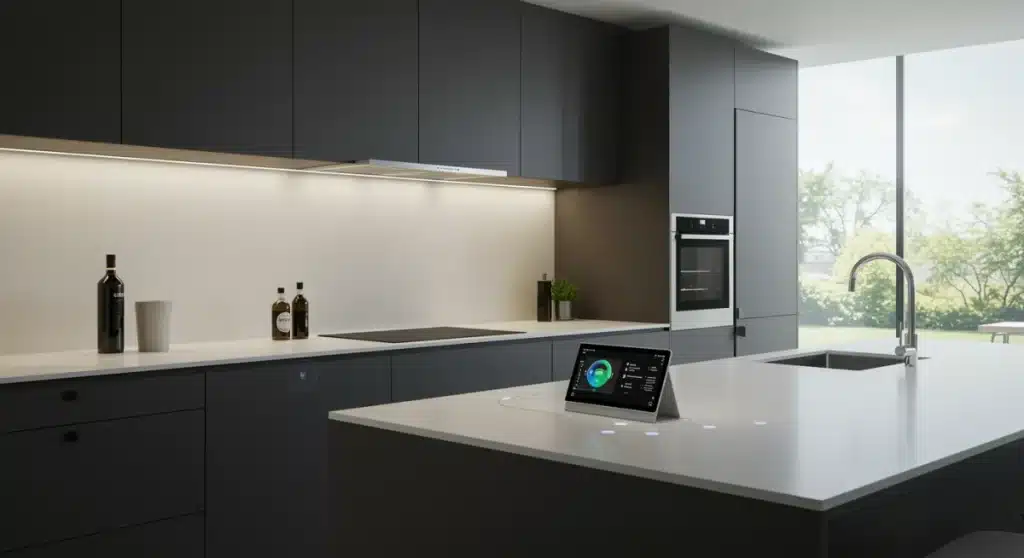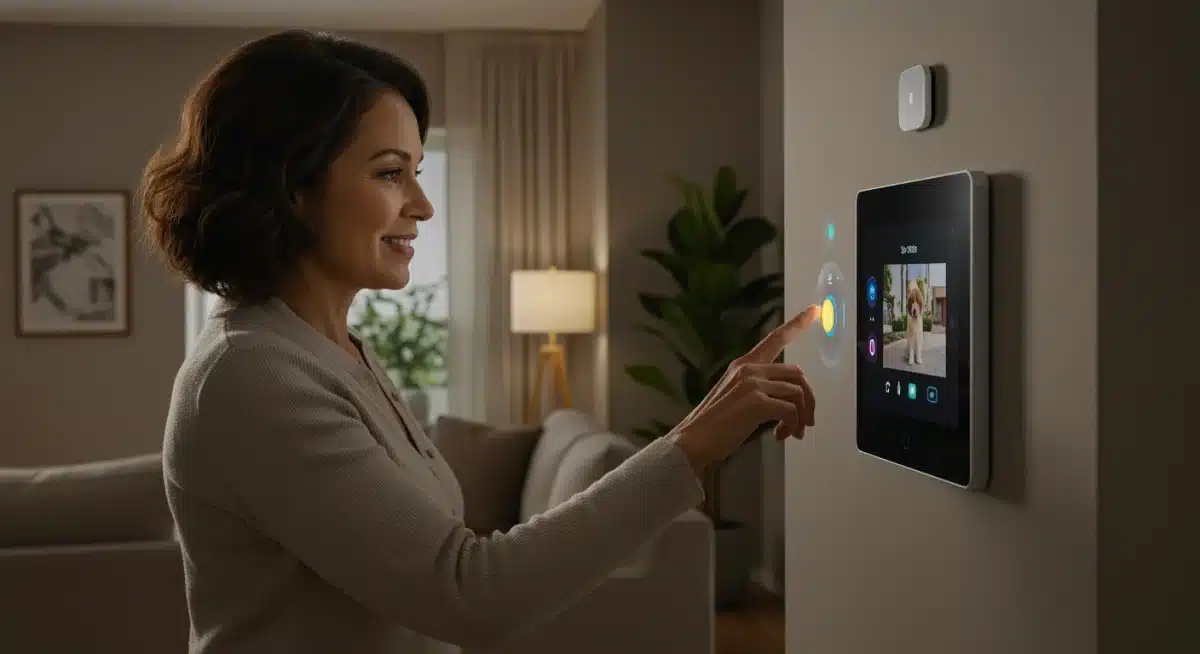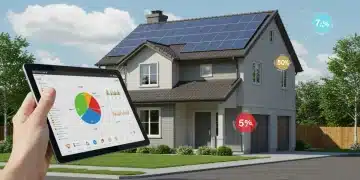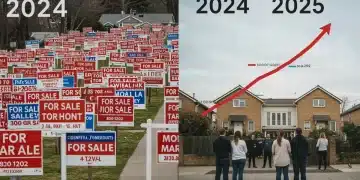Boosting Home Value with Smart Technology: 2025 Guide for US Sellers

As the 2025 real estate market approaches, understanding how to maximize your property’s appeal and price is paramount.
Boosting Home Value with Smart Technology: A 2025 Guide for US Sellers (FINANCIAL IMPACT) is no longer a luxury but a strategic necessity, offering tangible returns and a competitive edge.
The Evolving Smart Home Market and Buyer Expectations
The landscape of homeownership is rapidly shifting, driven by technological advancements and changing consumer preferences. Buyers in 2025 are not just looking for a house; they are seeking an integrated living experience, where convenience, security, and energy efficiency are seamlessly woven into the fabric of their daily lives. This demand for smart homes is profoundly influencing property valuations.
Recent market analyses, including those from the National Association of Realtors (NAR) as of late 2024, indicate a growing trend in buyer willingness to pay more for homes equipped with smart technology. This isn’t merely about individual gadgets; it’s about cohesive, interconnected systems that offer real, perceivable benefits. As such, sellers must strategically invest in these areas to meet and exceed these evolving expectations, ensuring their property stands out in a competitive market.
Key Smart Home Features in Demand
Prospective buyers are increasingly prioritizing certain smart home features. Understanding these can guide sellers in their upgrade decisions.
- Smart Thermostats: Devices like Nest or Ecobee offer significant energy savings and remote control, appealing to eco-conscious buyers.
- Integrated Security Systems: Smart locks, doorbell cameras, and comprehensive alarm systems provide peace of mind and enhanced safety.
- Smart Lighting: Dimmable, color-changing, and automated lighting systems add ambiance, convenience, and energy efficiency.
- Voice Assistants: Integration with platforms like Amazon Alexa or Google Assistant for centralized control of various smart devices.
Financial Impact: Quantifying Returns on Smart Tech Investments
Investing in smart home technology is not just about modernization; it’s a calculated financial decision that can yield substantial returns. The ROI on various smart home upgrades can vary, but studies consistently show a positive correlation between smart tech integration and increased property value. For US sellers aiming for maximum financial impact in 2025, understanding these potential returns is critical.
According to a 2024 report by Coldwell Banker Real Estate, homes with smart technology sell faster and for higher prices than comparable non-smart homes. This premium can range from 1% to 5% of the home’s total value, depending on the extent and quality of the installed systems. This financial boost is particularly pronounced in urban and suburban markets where technology adoption is higher. Smart security systems, for instance, are often cited as one of the most impactful upgrades, not just for perceived safety but also for potential insurance premium reductions.
Calculating Your Potential ROI
To assess the financial impact, consider the following:
- Cost of Installation: Factor in both device cost and professional installation if required.
- Energy Savings: Highlight long-term savings from smart thermostats and lighting, which are attractive to buyers.
- Insurance Reductions: Many insurance providers offer discounts for homes with integrated security and fire detection systems.
- Market Demand: Research local market trends to identify which smart features are most valued in your specific area.
Ultimately, the goal is to present a home that is not only aesthetically pleasing but also technologically advanced and economically advantageous for the prospective buyer.
Top Smart Home Upgrades for 2025 US Sellers
For US sellers looking to enhance their property’s value in 2025, focusing on highly desired and impactful smart home upgrades is essential. The market is increasingly sophisticated, and buyers are discerning, seeking technologies that offer genuine utility and integrate seamlessly into their lives. Prioritizing these upgrades can significantly boost your home’s appeal and ultimately, its selling price.
Data from leading real estate analytics firms, updated as of early 2025, indicates a clear preference for certain categories of smart devices. Energy-efficient solutions continue to dominate, reflecting both environmental consciousness and the desire for lower utility bills. Security enhancements also remain a top priority, offering peace of mind and tangible protection. Furthermore, systems that contribute to overall comfort and convenience are gaining traction, differentiating properties in a competitive market.
Essential Smart Upgrades
- Smart Thermostats (e.g., Google Nest, Ecobee): These devices learn homeowner preferences and optimize heating and cooling, leading to significant energy savings. Their ease of use and remote accessibility are major selling points.
- Smart Lighting Systems (e.g., Philips Hue, Lutron Caséta): Beyond simple on/off control, these systems offer dimming, color customization, and scheduling, enhancing ambiance and energy efficiency.
- Smart Home Security (e.g., Ring, Arlo, SimpliSafe): This category includes smart doorbells with cameras, smart locks, motion sensors, and integrated alarm systems, providing comprehensive protection and remote monitoring.
- Smart Appliances (e.g., Refrigerators, Ovens, Washers/Dryers): While often a larger investment, connected appliances that offer remote control, diagnostic capabilities, and optimized performance can be a significant draw, particularly in luxury segments.
- Smart Irrigation Systems: These systems conserve water by adjusting watering schedules based on local weather data, a feature increasingly valued for both environmental and cost-saving benefits.
Seamless Integration: The Key to a Higher Valuation
The true value of smart technology in a home extends beyond individual devices; it lies in their seamless integration into a cohesive ecosystem. A collection of disparate smart gadgets offers less appeal than a harmonized system where devices communicate and function together effortlessly. For US sellers in 2025, demonstrating this interconnectedness is paramount for a higher valuation.
According to smart home industry specialists speaking at the recent CES 2025 trade show, buyers are increasingly looking for homes where smart devices operate on a unified platform or through a central hub. This allows for simplified control, automated routines, and a truly intuitive living experience. A well-integrated system suggests a thoughtful, modern home, minimizing future headaches for the buyer who might otherwise face compatibility issues or complex setups. This level of sophistication translates directly into perceived value and desirability.
Achieving System Harmony
- Centralized Hub: Utilize a central smart home hub (like Apple HomeKit, Samsung SmartThings, or Google Home) that can control multiple devices from different manufacturers.
- Voice Control: Ensure compatibility with popular voice assistants so buyers can intuitively manage their smart home.
- Automated Routines: Showcase pre-programmed routines, such as ‘Good Morning’ (lights turn on, thermostat adjusts) or ‘Away’ (lights off, doors lock, security activates).
- Professional Installation: While DIY is possible, professional installation often ensures optimal performance and a polished, integrated look.
Highlighting the ease of use and the interconnected nature of your smart home system during showings can significantly influence buyer perception and willingness to pay a premium.

Marketing Your Smart Home: Highlighting Tech Advantages
Once your home is equipped with smart technology, effectively marketing these features becomes crucial for maximizing your financial return. For US sellers in 2025, simply having smart devices isn’t enough; you must proactively communicate their benefits and how they enhance the living experience. This strategic promotion can attract tech-savvy buyers and justify a higher asking price.
Real estate agents across the country are advising sellers to specifically call out smart home features in their listings, open house materials, and property tours. As reported by Zillow Group in its Q4 2024 market report, listings explicitly mentioning smart thermostats, smart locks, or integrated security systems receive significantly more views and inquiries. Buyers are actively searching for these amenities, and making them prominent in your marketing strategy can create a distinct advantage.
Effective Marketing Strategies
- Detailed Listing Descriptions: Beyond just listing ‘smart thermostat,’ explain the benefits like energy savings and remote control.
- High-Quality Photography and Video: Showcase smart devices in action. A video tour demonstrating how the smart home system works can be incredibly impactful.
- Dedicated Smart Home Section: Create a separate section in your property brochure or online listing detailing all smart features and their advantages.
- Educate Your Agent: Ensure your real estate agent is knowledgeable about your smart home features and can effectively demonstrate them to potential buyers.
- Leave User Manuals/Guides: Provide clear instructions or quick guides for the smart systems, reassuring buyers about ease of use.
Future-Proofing Your Home: 2025 and Beyond
As technology continues its rapid evolution, homeowners and sellers must consider not just current trends but also how to future-proof their properties. For US sellers navigating the 2025 market, investing in smart technology that is adaptable and upgradable can offer sustained value and appeal for years to come. This forward-thinking approach minimizes the risk of obsolescence and maximizes long-term financial impact.
Industry analysts, including those from Gartner’s 2025 technology forecasts, emphasize the importance of open-standard systems and devices that support interoperability. Proprietary systems, while functional, can limit future expansion or integration with new technologies. Buyers are increasingly aware of this, preferring homes that offer flexibility and the ability to evolve with future innovations. This focus on future-proofing can be a significant differentiator in a market where technology is constantly advancing.
Considerations for Long-Term Value
- Open Standards: Prioritize devices that support widely adopted protocols like Zigbee, Z-Wave, or Matter, ensuring broader compatibility.
- Modular Systems: Opt for systems that allow for easy addition or replacement of components rather than monolithic, difficult-to-upgrade setups.
- Software Updatability: Choose devices from manufacturers known for regular software updates, which can add new features and improve security over time.
- Network Infrastructure: Ensure robust Wi-Fi coverage and potentially wired Ethernet drops in key areas to support future bandwidth-intensive smart devices.
By making strategic choices now, sellers can ensure their smart home investments continue to deliver value and remain attractive to future generations of buyers.
| Key Point | Brief Description |
|---|---|
| Evolving Buyer Demand | 2025 buyers prioritize integrated smart homes for convenience, security, and energy efficiency, influencing property valuations. |
| Quantifiable ROI | Smart tech investments can yield 1-5% higher selling prices and faster sales, plus potential insurance savings. |
| Seamless Integration | Cohesive, interconnected smart systems offer greater appeal and value than individual gadgets. |
| Future-Proofing | Invest in adaptable, upgradable smart technology using open standards for sustained long-term value. |
Frequently Asked Questions About Smart Home Value
Smart thermostats, integrated security systems (smart locks, doorbell cameras), and smart lighting consistently offer high returns. These features appeal to a broad range of buyers due to their energy-saving, security-enhancing, and convenience benefits, leading to higher valuations and quicker sales.
Reports suggest smart technology can boost a home’s value by 1% to 5% of its total price. This percentage can vary based on the extent of integration, the specific technologies installed, and local market demand. Comprehensive, interconnected systems tend to yield the highest financial impact.
While many smart devices are DIY-friendly, professional installation is often recommended for complex systems or when aiming for seamless integration. Professionals ensure optimal performance, proper setup, and a polished appearance, which can be crucial for impressing potential buyers and maximizing value.
Clearly highlight smart features in listing descriptions, using high-quality photos and videos. Create a dedicated section detailing the benefits, and ensure your real estate agent can demonstrate the systems. Provide simple guides to reassure buyers about ease of use and long-term convenience.
Future-proofing means choosing smart devices and systems that are adaptable, upgradable, and support open standards (like Zigbee, Z-Wave, or Matter). This ensures compatibility with future technologies, allows for easy expansion, and prevents rapid obsolescence, maintaining long-term value for your property.
What Happens Next – Smart Homes and the Future of Real Estate Value
As the real estate market continues its rapid digital transformation, smart home technology is moving from a luxury feature to a defining standard of property desirability. The convergence of automation, data intelligence, and sustainable design is shaping the next generation of residential living—where convenience, energy efficiency, and security are seamlessly integrated. This evolution is expected to influence not just buyer preferences but also how properties are valued and marketed in a competitive housing landscape.
For homeowners and sellers, embracing AI-driven automation, connected energy management systems, and adaptive lighting or security networks can translate into measurable increases in resale potential. Studies and insights, such as those outlined in Redfin’s analysis of how home automation can increase property value, highlight how smart technology investments often yield strong returns, particularly when paired with effective digital marketing strategies that showcase these upgrades.
Looking forward, the continued rollout of universal interoperability standards like Matter will simplify integration across devices, allowing smart ecosystems to become more intuitive and accessible. We can also expect AI personalization tools to enhance user experiences—anticipating occupant needs and optimizing energy use—making these homes both intelligent and environmentally responsive. Sellers who adopt and promote such technologies early will secure lasting advantages, differentiating their properties in a market increasingly driven by digital sophistication and sustainability metrics.
Ultimately, the next phase of the housing market will not just reward curb appeal—it will value connectivity, adaptability, and innovation. Those who understand and implement smart infrastructure today are not only improving comfort and efficiency but are actively future-proofing their property’s worth in the evolving economy of intelligent living.





